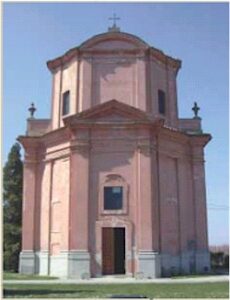Address: Via Madonna della Salute, 69
Description:The Sanctuary of the Madonna della Salute (the Madonna of Health) in Solarolo rises near the town in the open countryside. It was built between 1731 and 1735 and is an octagonal structure with four chapels. The exterior is divided into two orders following the 1500’s tradition with protruding pilaster strips and cornices with a clean and precise profile. The only concession to 1700’s features is the arched gable on the upper section, differentiated from the triangular gable on the lower section.
There was also a bell tower with an onion shaped spire, which unfortunately disappeared after the war. The inside is characteristic for its columns placed in the corner of the octagon to hold up the heavy solid architrave and large cornice, which in turn encloses the whole area including the chapels. Above the cornice the wall is decorated with flatter and less obvious cornices and panels. Above the small cupola there are four windows inserted into grooves and the small cupola itself is divided by very slight ribs into uneven sectors. On the upper level the octagon becomes irregular.
At floor level in the walls between the columns there are doors that open with coretti on top decorated with baroque style stucco plates, a rare concession by architect Carlo Cesare Scaletta following the trends of the period. The altar is the home of the holy image of the Madonna della Salute and is the work of sculptors Giovanni and Domenico Fuschini. The rise is made up of four columns to support a broken gable with a large central plate. It is made of Istria stone and noble marble of different colours and was completed in 1746.
The holy image of the Madonna della Salute is not one to be admired for the quality of its art or the fame of its artist and yet its relatively brief existence contributed to providing comfort and relief from tribulations. The image depicts a Madonna with Child and is in relief terracotta from mould, decorated on engobe, a poor ceramic technique typical of sacred images destined to large diffusion. The plate measures 23×43 and the bright coloured décor is the same that can be seen in common 17th century crockery. A careless collage carried out without too much care after the holy image was damaged in the second world war determined the recent decision for a scientific restoration carried out at the “G. Ballardini” Institute of Faenza.
Additional notes: The Sanctuary houses a museum that is open every day with free admittance and houses a collection of approximately 200 votive tablets from the 18th century to the present day.
Weekdays: from 8.00 am to 7.00 pm
Sundays and public holidays: Holy Mass is celebrated at 10.00 am
Directions: The Sanctuary is located app. 1 km from the town centre.



